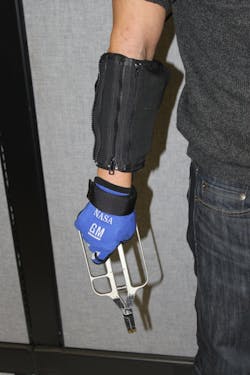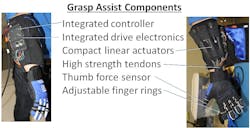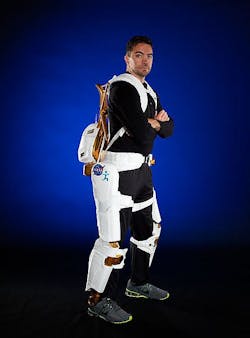NASA Robot Spawns Biomedical Spinoffs
Robonaut, a human-like robot designed by NASA and General Motors, has been undergoing tests onboard the International Space Station to determine if it can handle various tasks and free up human crew time—especially tasks that must take place outside the safety of the space station. But test results inspired researchers to repurpose the technology behind Robonaut for biomedical projects and products, among them an exoskeleton glove, exercise machine, and telemedical surgeon.
RoboGlove features flexible tendons, a tendon drive subsystem, and sensors that measure the grasping force applied by the wearer. The glove also can either assist or resist movement. A major application of its assistive function could be for spacewalks. Extravehicular activity work requires enormous hand strength,” said Lyndon Bridgwater, senior robotics engineer at Johnson. “Due to pressurization of the suit, it’s like squeezing a balloon every time you move your hand. That causes extreme fatigue and even injury. We’re looking at putting the hardware and actuator in the glove itself to provide muscle augmentation for the hand.” Ground testing of this application is scheduled for next year.
Similar applications could help people who have loss or restriction in use of a hand through injury or stroke, as well as those who do difficult, repetitive tasks at work. For example, installing car windows requires high hand strength to hold the heavy glass. Four copies of the glove in various sizes are currently being evaluated for these various uses. NASA and GM are looking for commercial partners to cost-effectively mass-produce the glove.
Another spin-off sprung from a partnership between NASA and the Florida Institute for Human and Machine Cognition (IHMC). That team developed the X1, an exoskeleton which could help astronauts remain healthy in space. On Earth, it could restore limb motion for people affected by paraplegia or stroke.
IHMC, which had already developed a lower-extremity exoskeleton to help those with paraplegia, contributed its expertise in walking algorithms related to gait pathology. NASA added its expertise in actuation and hardware, and the team created the X-1—a more compact, capable exoskeleton.
In addition to assisting movement, the exoskeleton can also inhibit it. This means it could be adapted for use as a resistance exercise device for astronauts on long missions. Astronauts exercise, on average, two hours a day on the station to counter the effects of microgravity, which decreases bone density and atrophies muscles. Although existing exercise equipment is effective at maintaining crew health onboard the station, X1’s smaller size and mass make it more suitable for longer space missions.
X1 can also function as a dynamometer to measures force or torque and quantify changes in muscle strength. Currently, an off-the-shelf dynamometer measures an astronaut’s pre- and post-flight strength. The exoskeleton could be used for these assessments and take measurements during missions, letting crew immediately change or create new exercises in response to changes.
A third spin-off applies the technology to telemedicine. In tests with Houston’s Methodist Hospital, operators guided by a physician were able to use Robonaut to conduct ultrasound-guided venous access (inserting a needle into a vein). It may be possible one day to program the robot to carry out medical procedures on the space station under remote supervision of a doctor.


